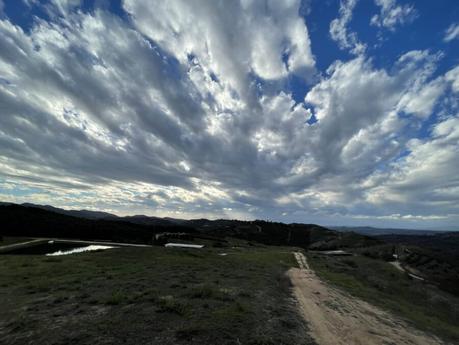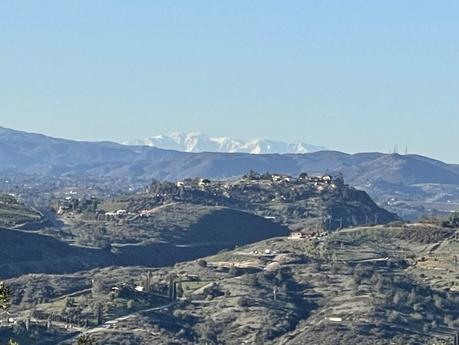
It’s fun to tour the avocado groves after the rain storms, even though the breeze is cold and stings my face. The smell of the freshly watered soil and an occasional waft of sweet blosssoms reminds me that winter is just about over. Clouds make dramatic statements in the sky, with some teasing of blue skies and colorful sunrises or sunsets in between the storms.

The storms that came in February brought the water we were hoping for, and thankfully very little wind. Beautiful showers lasted for days, with the rain coming straight down which a light whooshing through the trees. Reservoirs were filled, soil was saturated, and the avocado trees had plenty of water without need for irrigation.
Lots of Rain, Not Much Wind




When we don’t have heavy winds, the damages to the avocado grove are minimal. The water causes some erosion to the roads, and a few avocados did fall on the ground. But the reservoir is full, the trees have penty of water, the hills are turning green with wild plants (which farmers call “weeds”), and mushrooms are growing too!
Winter Into Spring





The breeze was cold as I drove around the ranch. As I came up to the crest of the hill, I startled a hawk, who was swooping up from below to sit on a water pipe. Instead the bird changed directions as if to say, “What are YOU doing here?” I found lots of baby avocados, some the size of tiny bb’s, and other as large as olives. Soil retention ponds were full, so that the run-off wouldn’t carry the topsoil into the reservoir. Snow on the local mountains was shining bright when the sun came out.
After the Storm Visitors: Birds!




For about a week after the rain storms, we had a cormorant hanging around the reservoir. He/She had big webbed feet like a duck, for swimming underwater to catch fish. We have some gold fish in our reservoir … not sure how many are left after the cormorant used our reservoir as a buffet. The beautiful white egret also stopped by for a snack – I’ve seen egrets eat lizards. The turtles in the reservoir didn’t seem worried about the birds. They floated near the top of the water while the cormorant was swimming by.
It’s Not Too Early for Rattlesnakes


The weather warmed up for a few days, and then the cold rains came back. Leia suddenly wasn’t feeling well, so M took her to the urgent care. We were surprised that she had been bitten by a rattlesnake, but it makes sense that the warm weather would wake them up, or perhaps the rains drove them out of their winter homes. Leia was treating with anti-venum and pain killers, and after a few days she felt much better. She needed to rest for a week or so, but she’s back to her normal life of keeping track of the activity on the ranch now.
Garden Flowers in February




I’m always surprised when the spring bulbs begin blooming in California. I grew up in Vermont where the snow and cold make us wait until late spring before we see anything growing. In Southern California we can begin to have spring flowers in January. By the first of March, we now have lots of freesias, daffodils, and camellias. The wild spring flowers will be blooming by April. We scattered some wild flower seeds while the ground was wet, hoping to enjoy some colorful flowers during the summer.
The avocado crop is sizing up, and harvest is slowing getting started. Only the largest fruit will be picked for markets right now, unless farmers are stripping the trees in preparation for stumping.
Water Prices are High, Trees are Coming Down




As more rain falls in Southern California, the water districts raise the prices to make up for the lost water sales. The cost of labor continues to go up, as well as the insurance that farms must buy. As costs of production rise, farmers have to make some tough decisions. We can’t afford to grow avocados when the costs are higher than the prices we can get for the fruit.
It’s not easy to decide to cut down the trees. Which ones must go? Trees that are in the path of storm winds will be cut down. Trees that do not have high production will be cut down. Some tall trees will be stumped and allowed to regrow so they can produce avocados in a few years. Older trees will not be allowed to regrow. The newer trees with root stocks that can tolerate salty water have already been planted and are slowly coming into production as they grow over several years.
The trees are budding and soon it will be time for all of them to start blooming. The earliest varieties like Carmen Hass are already blooming. The apiary will deliver stacks of bee hives to pollinate the avocado flowers during the season.
And the hawks keep watch over the groves.
Need Fresh California Avocados?
California Avocados Direct is the website where avocados and oranges from our family farm are sold in gift boxes and subscriptions all over the USA. Picked fresh, packed by hand, and sent to your door!
